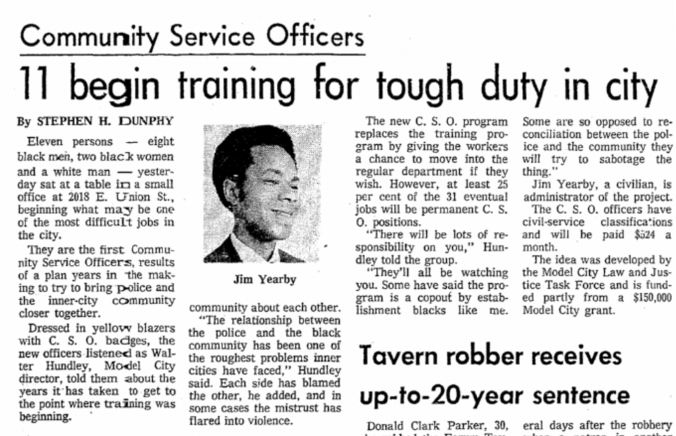
By Paul Kiefer
The re-launch of the Seattle Police Department’s Community Service Officer (CSO) unit at the end of 2019 was quickly overshadowed by a global pandemic. In the two years since, the unarmed civilian team has mostly remained under the radar, handling non-emergency calls, connecting runaway kids and domestic violence victims to service providers, and doing meet-and-greets at neighborhood events.
Seattle Mayor Jenny Durkan’s 2022 budget proposal would add six new officers to the CSO program, making it the only police department program to gain new full-time positions next year. Durkan’s plan would bring the total funded positions to 24; the team is still waiting to fill 10 existing positions that have been vacant since the beginning of the summer, so bringing the program to full strength would mean hiring 18 more people.
In some ways, the city council’s vocal support for scaling up alternatives to traditional (armed) police puts the CSO program in an advantageous position: instead of bulletproof vests and a gun belt, the CSOs wear light-blue polo shirts and walkie-talkies. But the unit is still part of SPD, and despite pressure from some activists to move the program to a civilian department, the CSOs themselves have been clear that they want to stay put. At the same time, some of the unit’s responsibilities seem increasingly redundant in a growing ecosystem of civilian-led public safety services.
During one week in late September, CSOs appeared at six community gatherings in an effort to “build positive rapport” with community members; according to Chris Inaba, one of the unit’s two civilian supervisors, the purpose of those appearances is both to introduce community members to the CSO program and to act as friendly ambassadors for SPD.
For the police department, the CSO program serves both as an in-house patrol support team and a community relations tool: A friendly, approachable face for a department that is desperately trying to regain public trust. As Seattle shifts its energy toward civilianizing public safety, the CSO program is the department’s most saleable asset—and one that could, according to program leaders, play a key part in reconnecting the city to SPD.
During one week in late September, CSOs appeared at six community gatherings in an effort to “build positive rapport” with community members; according to Chris Inaba, one of the unit’s two civilian supervisors, the purpose of those appearances is both to introduce community members to the CSO program and to act as friendly ambassadors for SPD.
Inaba was one of the first people the department hired when the city finally reassembled the CSO program in 2019. Before joining SPD, he spent three years working for the Downtown Seattle Association as a safety supervisor and outreach case manager.
Though the current CSO program is still finding its footing, the concept isn’t new to Seattle. The department originally launched the program in the early 1970s in a bid to de-escalate tensions between SPD and Black residents of the Central District—tensions driven by allegations of racist policing and excessive force by the department’s officers—and to create a recruitment pipeline for Black police officers. For 33 years, the unit handled everything from landlord-tenant disputes to reconnecting homeless youth with their families. But after a series of budget cuts under then-mayor Greg Nickels, SPD disbanded the original CSO program in 2004.
Over one week in September, SPD’s patrol staff handed off calls to CSOs ten times. In one case, the officers found shelter space for a homeless family; in another, an officer paid for an Uber to take a domestic violence victim to a friend’s house after connecting them to an advocate.
When SPD and then-City Councilmember Mike O’Brien announced plans to revive the program in 2017, SPD was entangled in allegations of racially biased policing and excessive force—and, as a result, five years into an oversight agreement with the US Department of Justice known as the consent decree. Even before the department assembled a new CSO team, some community activists had already raised the possibility of moving the program out of SPD. But department leadership stood firm, arguing that the CSOs should act as a supplement to patrol, not an autonomous team of social service workers providing wraparound care.
With SPD’s ranks stretched thin after more than a year of high attrition, the CSOs have frequently served in this supplementary role. Over one week in late September, SPD’s patrol staff handed off calls to CSOs ten times. In one case, the officers found shelter space for a homeless family; in another, an officer paid for an Uber to take a domestic violence victim to a friend’s house after connecting them to an advocate.
Right now, Inaba said, the CSOs are among the only responders who have time to handle those tasks. “What we have is time, so we can help free up sworn officer to deal with other things while we help someone figure out where they can find what they need,” he said. In the past year, SPD patrol officers have called CSOs for support on more than 500 emergency calls; Inaba hopes that the city’s 911 dispatch will eventually be able to send CSOs directly to emergency calls, which be believes would add to their usefulness. Continue reading “SPD’s Community Service Officer is Poised to Grow, But the Program is Still Finding Its Feet”



